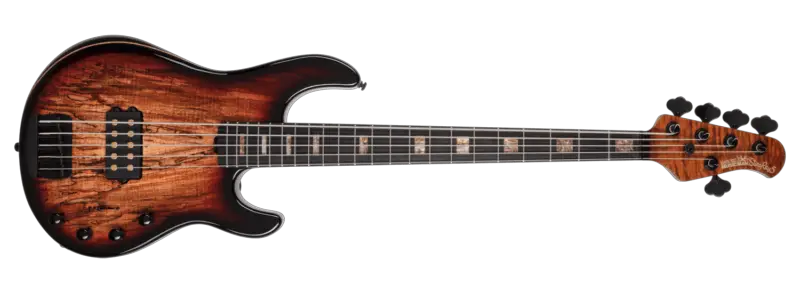For over 70 years, the Precision Bass, or P Bass, has been a cornerstone of the music industry, revolutionizing how musicians approach the low end. From its inception in the 1950s by Leo Fender, this iconic instrument has evolved and influenced generations of bass players.
With its distinctive sound and solid body construction, the P Bass quickly became a favorite among musicians of various genres, from rock and blues to funk and jazz. Its precise tonal capabilities and unparalleled playability have stood the test of time, making it a go-to choice for professional and amateur bassists.
But how did the P Bass achieve such legendary status? In this article, we will delve into the evolution of this iconic instrument, exploring its innovative features, design advancements, and influence on the music industry. Join us on a journey through time as we uncover the secrets behind the P Bass’s success, from its humble beginnings to its place as a revered symbol of bass excellence.
So grab your bass and prepare to dive into the rich history of the P Bass. This instrument has taken the art of bass playing from precision to perfection.
Table of Contents
P Bass history and evolution
The story of the P Bass began in the early 1950s when Leo Fender recognized the need for a bass guitar that could provide a solid and consistent tone. At the time, most bass players were using upright basses, which were large and cumbersome. They tended to be unreliable in terms of sound projection.
Fender’s solution was to create an electric bass guitar that could replicate the sound of an upright bass while offering improved playability and portability. 1951, the first Precision Bass was born, featuring a solid body construction, a single-coil pickup, and a fretted neck. This groundbreaking instrument allowed bass players to achieve a more defined and controlled sound called “Precision Bass.”
Over the years, the Pre3cision Bass underwent several design advancements and refinements. In 1957, Fender introduced a split-coil pickup, enhancing the instrument’s tonal capabilities. The addition of a second pickup in 1958, known as the “stacked” pickup, gave bassists even more versatility, allowing them to blend different pickup combinations to achieve a wide range of tones.
The impact of the P Bass on the music industry
The introduction of the P-Bass profoundly impacted the music industry. Before its creation, bass players were often relegated to a supporting role in bands, overshadowing their instrument’s sound by other instruments. However, the P Bass changed that dynamic by providing a robust, distinctive bass tone that could cut through the mix.
This newfound prominence of the bass guitar had a ripple effect on music creation. Bass players began experimenting with new techniques and styles, pushing the boundaries of what was possible on the instrument. The P Bass became a driving force in popular music, influencing genres such as rock, blues, funk, and jazz.
Key features and specifications of the P Bass
The P Bass is known for its distinctive features and specifications, contributing to its unique sound and playability. One of the most significant features is its split-coil pickup, which provides a deep, punchy tone with plenty of low-end definition. The fretted neck allows for precise intonation and accuracy, while the solid body construction provides sustain and stability.
In terms of specifications, the Precision Bass typically has a 34-inch scale length, a maple neck, and a rosewood or maple fretboard. The body is usually made of alder or ash, which contributes to the instrument’s resonance and tonal characteristics. The Precision Bass also features a comfortable and ergonomic design, allowing hours of playing without fatigue.
Famous musicians and their use of the P-Bass
Famous P Bass Players
Throughout its history, numerous legendary bass players have favored the P Bass. One of the most notable users of the P-Bass is James Jamerson, who played on countless Motown hits in the 1960s and 1970s. His melodic and innovative bass lines played on a P Bass, became the foundation for many iconic songs.
Other famous P Bass players include Paul McCartney, who used the instrument extensively during his time with The Beatles, and John Entwistle of The Who, known for his aggressive and virtuosic bass playing. Jaco Pastorius, considered one of the greatest bass players of all time, also used a modified P Bass to achieve his unique and groundbreaking sound.
Precision Bass vs. other bass guitars – a comparison
While the Precision Bass has earned its place as an iconic instrument, it’s worth exploring how it compares to other bass guitars on the market. One of the main competitors is the Jazz Bass, also created by Leo Fender. The Jazz Bass offers a different tonal palette, with a brighter and more versatile sound than the P-Bass. It has a slimmer neck profile and two single-coil pickups, allowing greater tonal flexibility.
Another famous bass guitar is the Music Man StingRay, which has a distinctively bold and punchy sound. The StingRay features a humbucking pickup and an active preamp, providing a wide range of tones and a robust low-end response. These bass guitars have unique characteristics and appeal, catering to different playing styles and musical genres.

Tips for playing and maintaining the P Bass
Playing the P-Bass requires a combination of technique, musicality, and understanding of the instrument’s unique characteristics. Here are a few tips to help you get the most out of your P Bass:
1. Experiment with different playing techniques – The Precision Bass can produce a wide range of tones. Don’t be bold; explore other playing techniques such as fingerstyle, slap bass, and picking. Each method will bring out different nuances in the instrument’s sound.
2. Find the proper setup – Adjusting the action, string height, and pickup height can significantly affect the playability and tone of your P Bass. Experiment with different setups to find the one that suits your playing style and preferences.
3. Use the tone controls – The P Bass typically has a volume and tone control knob. Please pay attention to the tone control, as it can help you shape the overall sound of your bass. Experiment with different settings to find the sweet spot for your playing.
In terms of maintenance, regular care and attention will ensure your Bass stays in top condition. Keep the instrument clean by wiping it down after each use, and periodically change the strings to maintain optimal tone and playability. It’s also a good idea to have your Bass professionally set up and serviced regularly to address any issues and maintain its performance.
Collecting and investing in vintage P Bass guitars
Managing and investing in vintage Precision Bass guitars is a passion for many bass enthusiasts. Vintage P Bass guitars from the 1950s and 1960s are highly sought after due to their historical significance and unique characteristics. These instruments often have distinctive wear and patina, adding to their allure and value.
When investing in a vintage P-Bass, it’s essential to do thorough research and consult with experts to ensure the authenticity and condition of the instrument. Factors such as originality, playability, and rarity will influence the value of a vintage Bass. It’s also worth considering the investment potential of a particular instrument, as vintage bass guitars can appreciate over time.

Customization options for the P Bass
While the P-Bass is revered for its classic design and sound, many players customize their instruments to suit their preferences. Various aftermarket customization options range from pickups and electronics to alternative body and neck materials.
Changing pickups can significantly alter the tone of a P Bass, allowing players to achieve a broader range of sounds. Upgrading to higher-quality hardware, such as bridges and tuners, can improve the instrument’s overall performance and tuning stability. Custom finishes and artwork can also add a personalized touch to a P Bass, making it unique.
Conclusion: The enduring legacy of the P Bass
The Precision Bass has undoubtedly left an indelible mark on the music industry. Its revolutionary design, distinctive sound, and unwavering playability have made it a legendary instrument that has influenced generations of bass players.
From its humble beginnings in the 1950s to its place as a revered symbol of bass excellence, the P Bass has transcended time and musical genres. Whether you’re a professional musician or an aspiring bassist, the P Bass offers a gateway to exploring the rich history and endless possibilities of the low end.
So, please pick up a P Bass, plug it in, and embark on a musical journey that takes you from precision to perfection. The P-Bass awaits, ready to unleash its powerful and soulful voice, carrying on its legacy as an icon in the world of bass guitars.


